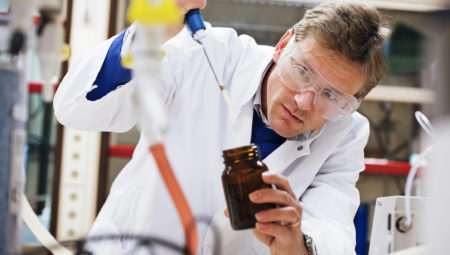The new Center Court location at Brightlands Chemelot Campus in Geleen welcomed a gathering of representatives from academia, the business community and government, who had come together to discuss the above challenges. Yvonne van der Meer (Maastricht University) kicked off the meeting. Van der Meer, who will focus on sustainability in AMIBM, emphasised that this aspect is essential for a market breakthrough of biobased polymers and products. ‘If that is not the case, an important USP drops out. Granted, biobased products generally mean lower CO2 emissions and require less fossil energy sources during production. But there are also downsides, such as possible consequences for food prices, and land and water use. We must take these factors into consideration in a model which unites economic, ecological and social factors. The aim is to end up with a specified standard that will have international support.’ According to Van der Meer, quantifying sustainability still faces the necessary challenges. This is partly due to missing or incomplete data and because certain factors such as biodiversity are extremely difficult to measure.
GalX
There are more than enough technological challenges, as numerous presentations at Brightlands Chemelot showed. One example is (partly) biobased polyamides which are derived from derivatives of galactaric acid (a by-product of sugar beet production). The structure of these monomers can improve the thermal properties of polyamides so that other applications come into the picture. However, the monomers are not very stable at high temperatures. The polymerisation fortunately proceeds smoothly at moderate temperatures. Ongoing research taking place under the AMIBM flag now shows that a type of monomer (GalX) can be used in amorphous polyamides which remain stable at temperatures exceeding 300 degrees Celsius. That means they can be processed further in plastic materials.
Cosun: derivatives pay
The above research is taking place under the name Beets 2 Polymers, a consortium which includes a supplier (Cosun), an end user (Philips) and a number of knowledge institutes such as Astron, Maastricht University and the University of Groningen. According to Alex Benschop, business development manager at Cosun Biobased, the biggest challenge is connecting business development with scientific research. ‘It is a long and winding road,’ according to Benschop, paraphrasing a song of The Beatles. The parent company of Suiker Unie nevertheless does see potential in derivatives from the sugar beet and pulp. The group of companies is focusing on four growth domains, says Benschop: vegetable proteins, healthy food, functional biopolymers and chemical building blocks. ‘Some of these chemicals already occur naturally in the beet, such as galacturonic acid which we can process via the beet pulp into a powder with a purity level of 99.5 percent.’ This galacturonic acid can in turn be converted into galactaric acid (and then GalX) in a catalytic process with high selectivity.
Long development time
Cosun is now planning a demo plant of approximately 100 tonnes galacturonic acid per year, more than enough for pilot production. The company also wants to scale up the production of galactaric acid, but that is where it stops for Cosun. That is why the group is looking for partners which will take over the baton and convert the galactaric acid into GalX and then process it in a polyamide. This material will enable the parties further in the chain, such as the compounders and end users, to test whether these materials meet the specifications. To put it briefly: it is a matter of perseverance. Jan Ravenstijn confirmed this in his presentation on the evolution of (new) polymers. Ravenstijn, with a long track record in polymer chemistry, claimed that it took between 15 and 20 years to develop a new polymer.
There goes another billion
‘It is a multidisciplinary, time-consuming and expensive activity,’ according to Ravenstijn. ‘You can “lose” a billion euros just like that. It is important that all parties have realistic ambitions. You can set hard deadlines, but in (research) practice, it is not so simple. That applies even more so to the market. With a price premium of 100 percent, you won’t make it. Premiums which fluctuate between 25 and 50 percent are acceptable, depending on the polymer. Coca-Cola is now willing to pay this kind of premium for its Plant Bottle, but does want to end up at lower price levels in the long term if the market volume – in this case, that of FDCA/PEF – grows.’
In conclusion, Ravenstijn emphasised the importance of cooperation in the value chain, an aspect which is also expressed in the AMIBM projects. ‘What sometimes still gets forgotten is that all the links in the chain have to benefit from it. Do not rely on laws and regulations either. These can change at any moment. Rather, work on the basis of the material itself and its advantages compared with customary materials.’





